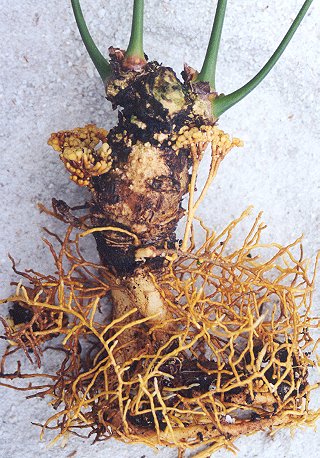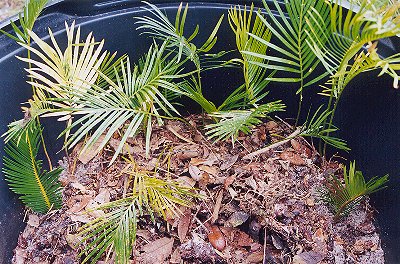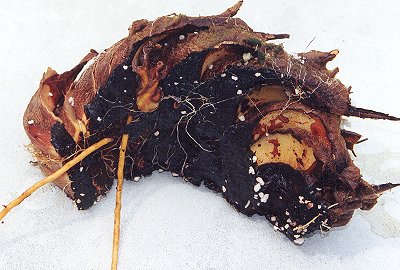 |
|
|
The most common way our cultivated cycads die is from the rotting of stems and roots. Most people will see their plant stop growing and wonder what is wrong, but do nothing. This is the first sign of root rot. They will wait until the leaves collapse before they wonder if something is wrong with their plant. In many cases, at this point it is too late. When the above ground stem totally rots away or is destroyed in a freeze, most people will discard the remains. In this article, I will tell you how to save your plants, as well as give you some insight into an unusual way of propagating your cycads.
Any cycad can be cut up into pieces to make a new plant. Each genus of cycad will produce growth from a different part of the plant. Zamia, Bowenia, and Stangeria will produce new plants from any part of the stem or root. Cycas species will produce new plants from the outside edge of the stem. These plants come from the leaf bases very much like offsets are produced. Ceratozamia, Encephalartos, and Macrozamia will produce plants from the leaf bases, as well as from the inside of the stem. Dioon produces plants from the area just inside the leaf bases. I have found that the leaf bases from a large Dioon can be two to three inches thick. I have not worked with the other genera to see from where the growth is generated. I would assume that Chigua is similar to Zamia. I would also assume that Lepidozamia and Microcycas are similar to Encephalartos. Any stem apex can be cut and prepared so new roots will grow from the base. It is interesting to note that the larger the cut on the stem, the more roots that will be produced.
Whether you are trying to produce more plants or trying to save a dying plant, the process is the same. The plant material must be sterilized as much as possible, then the material must harden before the new growth can be produced. When trying to grow roots on a damaged stem apex, you must cut it back until there is no rot showing at the base. All cuts need to be as smooth as possible. Any jagged edges can be a point for fungus to form. Next, soak the stem in a fungicide for a few minutes. I like to use Daconil, but there are many other products that will work as well. Remove the stem and let it air dry. Once it has dried, I like to paint the wound with black " tree sealer". Using tree sealer is not necessary, but I have found that using it will increase your success rate. The alternative is to let the wound dry for up to several days before planting. Once the stem is ready to plant, I place them in pure sand. Any inorganic, sterile medium will do but I personally like sand. I have found that perlite works very well, and seems to hold less water if you are in an area where moisture can be a problem. Place the stem in the shade, and do not water until it produces roots. If you live in a very arid part of the wourld, it would be good to lightly water every other week or so. If leaves are produced before the stem roots in, spray the leaves without letting the medium get too wet. I have talked to many people that have been lucky enough to purchase Encephalartos woodii offsets. Most of these people have told me that their plant produced leaves and then died. The secret to these plants is to cut the leaves off until the roots are produced. Without roots to pump water into the stem, the leaves will actually draw moisture out of the stem, and kill it. The "plant-to-be" can live off of the starch in the stem until roots are produced. If you are trying to save a plant where the apex has rotted, cut and treat the wound in a similar manner. Even though there are roots, do not over-water.
 |
|
|
Figure 1 shows a Dioon spinulosum that totally froze to ground level and rotted after the 1989 freeze, when temperatures went down to 17F . Notice that the growth came from an area close to the outside edge of the stem. Stem cuttings can be used to start new plants from all cycads. Usually, many plants can be produced from a single stem cutting. When working with Zamia, Bowenia, and Stangeria, I will make wafer-type cuts and process both sides the same as I mentioned before. I like to plant the stem cutting sideways, because I have found that new plants will be produced from both sides of the stem cutting. Also, moisture will not puddle on the top of the cut side as it would if planted the other way.
 |
 |
|
|
|
Figure 2 shows a Zamia pumila cutting planted in sand. Figure 3 shows the same cutting. Notice that there are seven new plants already growing from the one side of the stem. Even though there were no plants on the other side, this cutting had only been processed a few months before. Sometimes it will take up to a year before all the new plants appear.
 |
 |
|
|
|
Figure 4 shows a Bowenia spectabilis plant that had root rot. The root totally rotted, and then the apex collapsed. I sealed the apex as well as the bottom of the stem. The bottom has re-rooted, and two apexes have grown on the top. Several years ago, a friend of mine had a Cycas revoluta rot from the top. I asked him to give me a section of the remaining stem to experiment with. I cut the stem into sections, four inches thick. Figure 5 shows what was left of this section, three years later. I had already removed 75 plants from this one section. For the sake of this article I pulled it out, and found that in the last year it had produced even more offset type plants. Notice that all the plants are produced from the outside edge, and the center of the stem has rotted a long time ago. Even a small piece of a stem can produce more plants.
 |
|
|
Figure 6 shows a small piece of a Dioon edule stem. Notice the roots and the new plant is formed on the inside of the leaf bases. I had only planted this piece three months before. For the sake of this article, I pulled this piece out of the medium. It may not be obvious in the photograph, but there are five more callus areas already formed that will become new plants. In the next year, it is hard to say how many more will be produced. Any of these small plants can be separated after they are large enough to root on their own. In the case of Zamias, and other type plants, you can separate the small plants, or keep them the way they are to have a multi-headed plant. Just like offsets, the cutting will be a clone of the original plant. Every small stem cutting from a female Zamia, will produce a multi-stemmed, female plant. Stangeria can be started from very small pieces. One day, I noticed a root growing out of a hole in the bottom of the pot. I cut it off and planted it. Within four months, this small piece of root had started a new plant.
I hope this article has helped everyone understand how to save your cycad plants from certain death in the case of rot. So many times people will let their plant totally die, because they do not know what to do to save them. I am not suggesting for everyone to go out and cut up all your cycads, but it is interesting to know that these plants can be propagated in such a manner. Cycads are rare enough as it is, without people losing their existing plants to damage. With a lot of practice, this procedure could be used to mass-produce rare plants, especially those species with only one sex remaining on earth.
